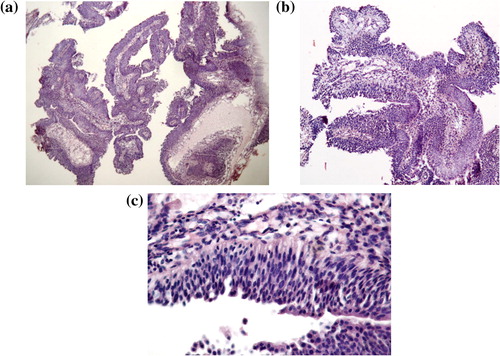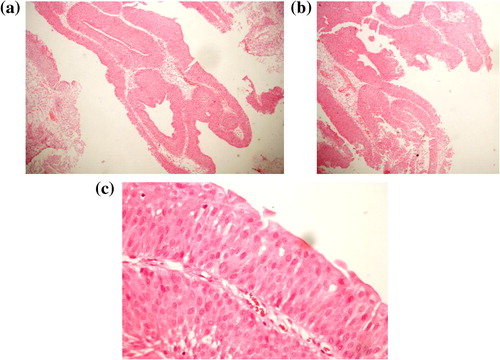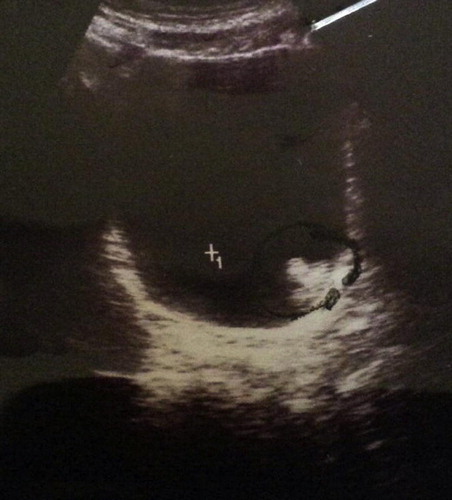Abstract
Urothelial bladder tumour in childhood is extremely rare, and almost all the reported cases have been low-grade tumours with a favourable outcome. Here we review 57 reports comprising 127 cases, and we report two new cases.
Keywords:
Introduction
Urothelial bladder tumour in childhood is extremely rare [Citation1]. Deming (cited in [Citation2]) reported the first such case, in a patient aged <10 years, in 1924. In 1969, Javadpour and Mostofi [Citation2] identified 40 primary epithelial bladder tumours in the first two decades of life from 10,000 total cases.
A more recent review of previous reports identified 125 patients who were aged <20 years, of whom only 20 were aged <10 years [Citation3], and the origin of such cases was mesodermal; reports on this topic are very limited. These tumours have been shown to have a low grade of malignancy, showing little tendency to recur [Citation4], and have a good prognosis. Here we review previous cases and report two new cases of urothelial bladder tumour.
Methods
We reviewed the databases of PubMed and Hinari for reports in English, searched using the keywords ‘bladder’, ‘transitional cell carcinoma’ and ‘children’. We identified 57 articles [Citation1–Citation57], comprising 127 cases (). We also describe two new cases.
Table 1 A review of the 127 cases: All the studies were of level of evidence 5.
Case 1
A 5-year-old boy from Hadramout, Yemen, presented in 2009 with 1 week of gross haematuria and interrupted urinary stream. There was no significant family, present or previous history. On physical examination at the time of presentation, the patient’s vital signs were stable. The abdomen was not tender and not distended. There were no associated anomalies.
There was no recurrence after a 3-year follow-up using abdominal ultrasonography (US) and cystoscopy, with assessments every 3 months in the first year then every 6 months thereafter. (a–c) shows the histological findings. Sections showed elongated papillary fronds lined by several layers of transitional cells with slightly enlarged crowded nuclei. There was no frank pleomorphism and no stromal invasion. The diagnosis was papillary urothelial neoplasm of low malignant potential (PUNLMP, WHO grade I).
Case 2
A 12-year-old boy from Baghdad, Iraq, presented in August 2013 with two recent attacks of painless haematuria and clots. His medical history indicated a previous appendectomy and tonsillectomy. He also had treatment for rheumatic fever. US and pelvic MRI showed a 2 × 1 cm posterior wall tumour. Cystoscopy was first used 3 months earlier in another hospital and revealed a fungating tumour at the left posterolateral wall near the left ureteric orifice. He underwent transurethral resection of the bladder tumour (TURBT), and the histopathology showed a papillary TCC of low grade and no stromal invasion.
In a reassessment, US showed a soft-tissue lesion in the left bladder wall (). Cystoscopy () showed a villous lesion above the left ureteric orifice of ≈ 2 × 2 cm in diameter. The tumour was resected (TURBT) and the bed cauterised.
The histopathology showed fragments of ulcerated bladder mucosa with intense mixed acute and chronic inflammatory infiltrate (–). There was one small fragment of papillary urothelium with enlarged crowded nuclei, consistent with low-grade papillary urothelial carcinoma (UC). There was no stromal invasion. The child is currently asymptomatic and follow-up cystoscopy is scheduled.
Figure 4 (a–c) Low- (×100) and high-power (×400) views showing the histopathology in sections with fragments of ulcerated bladder mucosa with intense mixed acute and chronic inflammatory infiltrate. There was one small fragment of papillary urothelium with enlarged crowded nuclei, consistent with low-grade papillary urothelial carcinoma. There was no stromal invasion. Haematoxylin and eosin stain.

Discussion
True urinary bladder UC in children is very unusual [Citation50], although there are occasional cases. In 1969, Javadpour and Mostofi [Citation2] identified 40 primary epithelial bladder tumours in patients in the first two decades of life, from 10,000 total cases. Most cases [Citation34] were papillary, in patients aged 6–20 years, and who presented with gross haematuria. In the first decade of life, primary bladder carcinoma was suggested to be even more uncommon [Citation10], with 30% of cases in children aged ⩽10 years [Citation49].
Williamson et al. [Citation50] warned that the diagnosis of urothelial tumours in children might be delayed. Urologists might be reluctant to evaluate these patients. The biological behaviour of the tumour must also be considered; the tumour might be of low grade but a follow-up is needed, especially in cases of multiple tumours.
Molecular studies suggest that tumours in children differ in their pathways from those in adult patients. Fine et al. [Citation19] reported a series of 23 urothelial neoplasms in patients aged ⩽20 years. They confirmed that these tumours were of low grade and had a low risk of recurrence.
Alanee and Shukla [Citation49] identified 140 cases of bladder cancer, with PUNLMP and rhabdomyosarcoma comprising 50.7% and 36.4% of the tumours, respectively. Between 1973 and 2003 the incidence of bladder malignancies increased significantly. The conditional survival calculated for 1 and 2 years after diagnosis was 93.6% and 97.5%. Fifty-one cases of embryonal rhabdomyosarcoma were identified. Reviewing the Surveillance, Epidemiology and End Results (SEER) database, they found that bladder cancer in children aged <18 years was rare, with only 140 patients registered in the SEER database during the period assessed. The results were consistent with previous multi-institutional studies for the higher incidence of PUNLMP in children. They also confirmed a high incidence of these tumours in males (male: female ratio, 3:1).
In the present review we excluded those patients with PUNLMP in the series reported by Alanee and Shukla [Citation49], as there is controversy about the diagnosis of PUNLMP and its accuracy in the SEER registry. The term PUNLMP was only introduced in 2004. In the same study, the survival curves should be considered carefully, as the addition of higher-grade tumours is a limiting factor. Furthermore, based on SEER analysis, there might have been errors in reporting one or more parameters of the malignancies [Citation49].
Data on the molecular characteristics and clinical behaviour of bladder tumours in children are less well understood than those of adult/elderly patients [Citation50,Citation51].
As for the follow-up assessments, CT and virtual cystoscopy are much less invasive [Citation52]. For practical purposes [Citation53–Citation55] patients with PUNLMP should be treated similarly to patients with low-grade, noninvasive UC. Molecular grading of these tumours can be used to further assess their biological potential [Citation56].
Because of the low but definite risk of recurrence and grade progression, an appropriate clinical follow-up of patients with primary PUNLMP is warranted [Citation57]. The 1998 WHO/ISUP classification of urothelial neoplasms can be applied reproducibly by pathologists, with a moderate level of agreement. PUNLMP lesions have a more sedate clinical behaviour than UCs but the hazard of recurrence and progression remains, and thus a follow-up is important [Citation57].
In the present report we included articles that were registered after 2004, as was one of the present cases (PUNLMP), but cases of PUNLMP before 2004 were not included.
A univariate analysis [Citation51] showed that high Ki67 expression and low cyclin D1 immunohistological expression were associated with a greater risk of recurrence in the ‘young’ group, while reduced p27Kip1 expression and p53 overexpression were not. By contrast, reduced p27Kip1 expression correlated with a greater risk of recurrence in elderly patients, suggesting that distinct molecular pathways might be involved in the development and progression of these tumours.
In the hereditary nonpolyposis colorectal cancer syndrome, there is a predisposition to urinary tract involvement [Citation51], but there could be an incidence of urothelial tumours in Costello syndrome [Citation22].
It appears that multiple tumours might be more likely to recur, and thus a periodic follow-up is mandatory. Cystoscopy in children is an invasive procedure that requires general anaesthesia, but it cannot be replaced by US and urine cytology. The present study has limitations, because it was retrospective and many abstracts were not available.
Funding
None.
Conflict of interest
None.
Notes
Peer review under responsibility of Arab Association of Urology.
References
- S.NeogiP.L.KariholuG.DhakreV.GuptaN.AgarwalP.BhadaniMalignant urothelial carcinoma of urinary bladder in a young child: a rare case reportUrology812013888890
- N.JavadpourF.K.MostofiPrimary epithelial tumors of the bladder in the first decade of lifeJ Urol1011969706710
- J.LerenaL.KrauelL.García-AparicioS.VallascianiM.SuñolJ.RodóTransitional cell carcinoma of the bladder in children and adolescents: six-case series and review of the literatureJ Ped Urol62010481485
- A.BujonsJ.CaffarattiJ.Maria GaratH.VillavicencioLong-term follow-up of transitional cell carcinoma of the bladder in childhoodJ Ped Urol20201314
- S.P.QuillinW.H.McAlisterTransitional cell carcinoma of the bladder in children: radiologic appearance and differential diagnosisUrol Radiol131991107109
- R.C.BensonJr.KM.TomeraPP.KelalisTransitional cell carcinoma of the bladder in children and adolescentsJ Urol13019835455
- A.YarmohammadH.AhmadniaM.Asl ZareTransitional cell carcinoma in children. report of a case and review of the literatureUrology22005120121
- D.M.HoenigS.McRaeS.C.ChenD.A.DiamondR.RabinowitzA.A.CaldamoneTransitional cell carcinoma of the bladder in the pediatric patientJ Urol1561996203205
- A.R.HuppmanB.R.PawelPolyps and masses of the pediatric urinary bladder: a 21-year pathology reviewPediatric Dev Pathol142011438444
- G.S.KorrectE.A.MinevichB.SivanHigh-grade transitional cell carcinoma of the pediatric bladderJ Ped Urol82012e36e38
- A.I.GhoushehC.T.DurkeeT.W.GrothAdvanced transitional cell carcinoma of the bladder in a 16-year-old girl with Hinman syndromeUrology80201211411143
- E.CompératP.CamparoS.LarréM.RoupretYNeuzilletG.PignotProg Urol232013171175
- G.CampoG.GiannariniG.PomaraF.ManasseroD.PistolesiC.SelliBladder papilloma in a 9-year-old girl: a case reportMinerva Pediatr642012361363
- E.RuizM.Alarcón CabaL.ToselliJ.MoldesM.OrmaecheaF.de BadiolaTransitional cell carcinoma of the bladder in adolescents: a diagnosis to bear in mind]Arch Argent Pediatr10720094952
- R.PatelT.TeryG.K.NinanTransitional cell carcinoma of the bladder in first decade of lifePediatr Surg Int24200812651268
- C.R.DowlingD.ReddihoughP.SmithN.WebbR.McNeillD.CloustonTransitional cell carcinoma in the paediatric population. Be aware of unusual aetiologiesJ Paediatr Child Health432007773775
- O.GülpinarT.SoygürS.BaltaciM.AkandD.KankayaTransitional cell carcinoma of bladder with lamina propria invasion in a 10-year-old boyUrology68200620412043
- S.AlamJ.GoebelM.C.PachecoC.SheldonPapillary urothelial neoplasm of low malignant potential in a pediatric renal transplant recipient (PUNLMP): a case reportPediatr Transplant112007680682
- S.W.FineP.A.HumphreyL.P.DehnerM.B.AminJ.I.EpsteinUrothelial neoplasms in patients 20 years or younger: a clinicopathological analysis using the World Health Organization 2004 bladder consensus classificationJ Urol174200519761980
- A.RodriguezD.BurdayW.SextonN.AhmadJ.M.Pow-SangUrothelial carcinoma in a childArch Esp Urol582005473475
- N.KilicT.TurkelE.BalkanB.SevinirTransitional cell carcinoma of the bladder presenting after blunt abdominal trauma: a very rare occurrence in childhoodInt J Urol122005316318
- S.UrakamiM.IgawaH.ShiinaK.ShigenoN.KikunoT.YoshinoRecurrent transitional cell carcinoma in a child with the Costello syndromeJ Urol168200211331134
- S.AgarwalaA.K.HemalA.SethA.K.GuptaV.BhatnagarD.K.MitraTransitional cell carcinoma of the urinary bladder following exposure to cyclophosphamide in childhoodEur J Pediatr Surg112001207210
- J.Mateos BlancoJI.Santamaría OssorioJJ.Pimentel LeoS.Sanjuán RodríguezTransitional-cell bladder tumor in childhoodCir Pediatr121999168170
- T.KawaguchiY.HashimotoH.KobayashiS.KudohS.TakahashiT.YanagisawaA clinical study of bladder cancer in adolescent patientsNippon Hinyokika Gakkai Zasshi901999614618
- A.Serrano-DurbáC.Domínguez-HinarejosC.Reig-RuizM.Fernández-CórdobaF.García-IbarraTransitional cell carcinoma of the bladder in childrenScand J Urol Nephrol3319997376
- J.Muñoz-Delgado SalmerónM.Fernández ArjonaS.ShihadehM.De la Fuente TrabadoJ.A.García EstevezBladder urothelial carcinoma in patients under 10 years of age: report of 2 new casesActas Urol Esp2119975759
- I.YusimL.LismerG.GreenbergK.HaomudJ.KanetiCarcinoma of the bladder in patients under 25 years of ageScand J Urol Nephrol301996461463
- M.CurtisA.SchnedS.HakimM.CendronPapillary transitional cell carcinoma of the bladder with lymphangiectasia in an 8-year-old boyJ Urol1561996202
- A.Sánchez DiazE.de Nova SánchezJ.C.Fernandez PuentesF.García LópezF.Llorens MartínezA.Orduña DomingoTransitional cell tumor of the bladder in children: report of a caseActas Urol Esp191995642645
- C.LaurentiC.De DominicisD.MattioliA.RocchegianiG.FrancoS.Dal FornoF.IoriTransitional cell neoplasm of the bladder in childhood: presentation of a clinical caseArch Esp Urol4619935154
- J.M.Pastor GuzmánAS.Salinas SánchezI.Hernández MillánM.Martínez MartínL.Cañamares PabolazaJA.Virseda RodríguezTransitional cell tumor of the bladder in childhoodActas Urol Esp161992524526
- D.Wilson-StoreyA.E.AllenS.VariendTransitional cell papillary bladder neoplasm in a girl: an unusual presentationJ Pediatr Surg271992113114
- I.MadgarB.GoldwasserO.NativY.HananiP.JonasLong-term followup of patients less than 30 years old with transitional cell carcinoma of bladderJ Urol1391988933934
- R.J.RaynerA.R.WatsonM.C.BishopHaematuria in an adolescent due to bladder carcinomaEur J Pediatr1471988328329
- L.PaduanoE.ChiellaPrimary epithelial tumors of the bladder in childrenJ Urol1391988794795
- I.MadgarO.NativY.HananiP.JonasTransitional cell carcinoma of the bladder in children under ten years of age. A case reportEur Urol141988216217
- J.E.OesterlingJ.I.EpsteinJ.P.GearhartTransitional cell carcinoma of the bladder in an adolescent with Turner’s syndromeJ Urol1371987398400
- B.LalmandE.F.AvniJ.SimonA.VerhestC.C.SchulmanJ.StruyvenTransitional cell papillary carcinoma of the bladder in a childPediatr Radiol1719877779
- D.van der VaerenP.HennebertP.J.van CanghEpithelial tumors of the bladder in children. Report of 2 casesActa Urol Belg481980459463
- W.MauermayerR.TauberG.SteuerEpithelial tumors of the urinary bladder in the first twenty years of life (author’s transl)Urologe A161977286289
- P.C.HandyM.G.PaiM.R.BudihalS.R.KaulgudCarcinoma of the bladder in young children: report of 2 casesJ Urol1131975264265
- R.D.CastellanosP.B.WakefieldA.T.EvansCarcinoma of the bladder in childrenJ Urol1131975261263
- S.MaklerC.A.SaenzPapillary carcinoma in a childRev Argent Urol Nefrol391970228230
- M.B.RossiH.WogalterM.SpatzPapillary transitional cell tumor of bladder in a 5-year-old boyJ Urol9719678889
- A.J.JohnsonJ.N.TaylorPapillary tumor of bladder in a twelve-year-old boyJ Urol871962869870
- A.BujonsJ.CaffarattiJ.M.GaratH.VillavicencioLong-term follow-up of transitional cell carcinoma of the bladder in childhoodJ Pediatr Urol102014167170
- S.M.DeLairR.W.WhiteE.A.KurzrockSecondary transitional cell carcinoma and nitrogen mustard treatmentUrology65200512261227
- S.AlaneeA.R.ShuklaBladder malignancies in children aged <18 years. Results from the surveillance, epidemiology end results databaseBJU Int1062009557560
- S.R.WilliamsonA.Lopez-BeltranG.T.MacLennanR.MontironiL.ChengUnique clinicopathologic and molecular characteristics of urinary bladder tumors in children and young adultsUrol Oncol Semin Orig Invest312013414426
- D.W.KeetchC.B.ManleyW.J.CatalonaTransitional cell carcinoma of bladder in children and adolescentsUrology421993447449
- A.H.GabrM.ElbadryA.ElsheriefR.TawfiekComputed tomography-virtual cystoscopy in the evaluation of a bladder mass: could it replace standard conventional cystoscopy?Arab J Urol112013369374
- M.YanaseT.TsukamotoY.KumamotoY.TakagiN.MikumaA.Iwasawaet alTransitional cell carcinoma of the bladder or renal pelvis in childrenEur Urol191991312314
- L.R.KhasidyB.KhashuE.C.MallettG.W.KaplanW.A.BrockTransitional cell carcinoma of bladder in childrenUrology351990142144
- K.W.GrippC.I.ScottJr.L.NicholsonT.E.FigueroaSecond case of bladder carcinoma in a patient with Costello syndromeAm J Med Genet902000256259
- T.D.JonesL.ChengPapillary urothelial neoplasm of low malignant potential: evolving terminology and conceptsJ Urol175200619952003
- T.K.LeeA.ChauxPapillary urothelial neoplasm of low malignant potential of the urinary bladder: clinicopathologic and outcome analysis from a single academic centerHuman Pathol42201117991803



